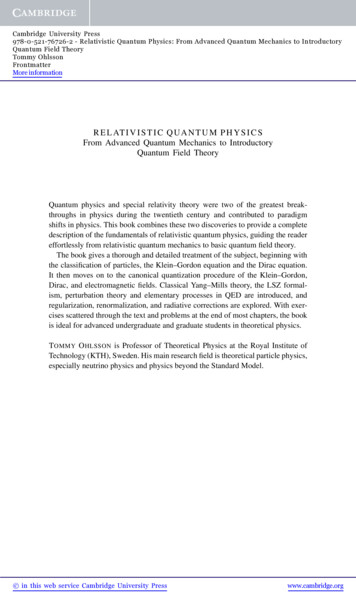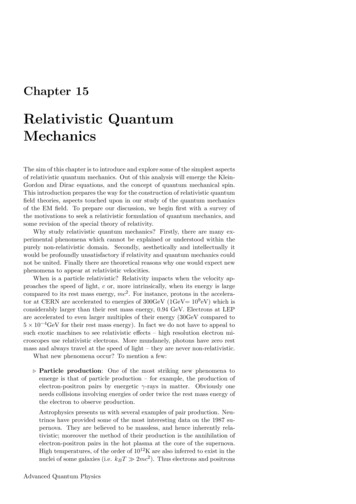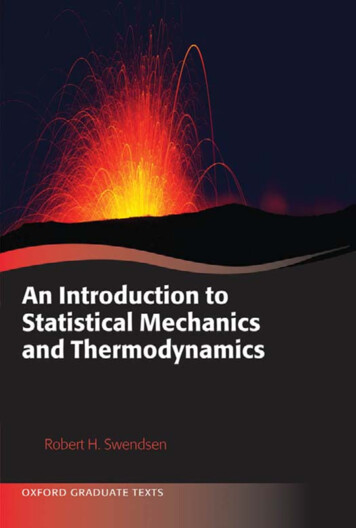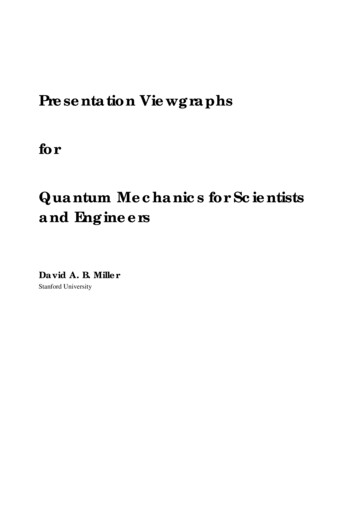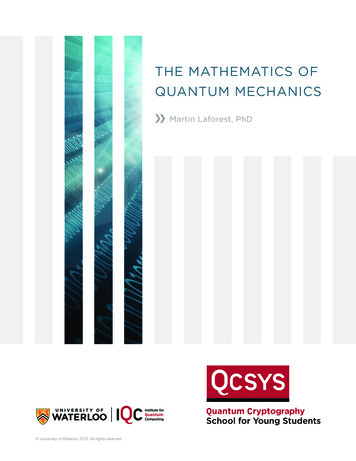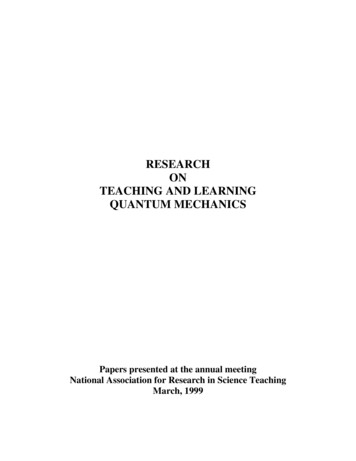
Transcription
Spring 2009Quantum Mechanics LabDuring the last few decades the investigation of atomic and molecular spectra has hada decisive influence on the development of our present ideas of atomic and molecularstructure.-Gerhard HerzbergInstructor InformationKerry Kuehn, Ph. D.Wisconsin Lutheran CollegeOff. (S133): 414.443.8850Lab. (S132): 414.443.8663URL: http://faculty.wlc.edu/kuehnEmail: kerry.kuehn@wlc.eduOffice Hours: M, W, F 9:00-9:50 a.m.M-F 6:45 - 7:30 a.m.Course description and summaryLaboratory work emphasizing spectroscopic techniques including acquisition and analysis ofrotational, vibrational and electronic spectra. 3 hrs. lab. Prerequisite: CHE 342/PHY 341 orconcurrent enrollment.Laboratory Session (Room S151)Formal laboratory reportsLaboratory PresentationCourse Grading ScaleA93-100%AB88-92%B80-87%BC75-79%Mon. & Fri. 12:30-3:20 a.m.Due prior to starting next labAs assignedCCDDF20% wgt.70% wgt.10% wgt.67-74%62-66%54-61%0-53%Course objectivesSuppose that you were a journalist preparing an article about how the United Nations works, and youwere granted three hours to interview anyone whom you wished. What would you do? Whom would youinterview? How would you formulate your questions? How would you know if what he or she told you wastrue?The two questions: Is this true? and How do I know? are two of the most important questions thatone can ask. How we answer them, and whether we even choose to ask them, has far reachingimplications on how we conduct our lives.Natural science is very similar to journalism in that we pose questions in hopes of finding outhow something really works. One of the most difficult parts is deciding what questions to ask soas to reveal the most essential truths about nature. The primary objectives of this course are todevelop in you1.that habit of asking questions, particularly in the context of the natural sciences, and2.the ability to answer them for yourself, by developing a rational experimental plan of actionQuantum Mechanics- Syllabus January 20091
Spring 2009Quantum Mechanics LabSince this is a course on quantum mechanics, we will be exploring phenomena that reveal thebehavior of matter on the atomic scale. So the secondary objectives of this course are to1.Apply spectroscopy and quantum chemical principles to practical laboratory experiments.2.Use data analysis to obtain useful physical properties for a given set of data using spreadsheets, linear regression analysis and graphing in a computer.3.Evaluate data and results based on previous knowledge of physical chemistry.4.Propagate experimental uncertainties in calculations.5.Write lab reports in the form of research articles.6.Verbally communicate spectroscopic and quantum data and ideas to others in an understandable way.Required equipmentSafety glasses, a laboratory notebook (details later) and a scientific calculator.Laboratory sessionsThere are four labs which you must accomplish during the course of the quarter. Lab 1: Atomic Spectra and the Rydberg Constant Lab 2: Absorption Spectra of Conjugated Dyes Lab 3: Rotational and Vibrational Spectra of HCl and DCl Lab 4: Computational labEach student will be assigned a letter, A, B, C or D. The order in which you will be assigned laboratory experiments depends upon your letter, as shown in the table below. You will have the samelab partner(s) for the first two labs, and a different partner for the last two labs. A formal lab report is required from each group for each lab. Also, each individual will be required to give oneformal laboratory presentation.Apart from the first lab period, you must read the assigned sections of the lab textbook beforecoming to lab. It is your responsibility to acquire the factual contents of the course. During yourassigned laboratory session you will be provided with equipment and some experimental guidelines; it will be your responsibility to devise experiments to gain as much information as you can.The instructor will serve as a guide so as to help you refine your experimental techniques andprocedures.Quantum Mechanics - Syllabus January, 20092
Spring 2009Quantum Mechanics LabStudentAMondayFridayStudentBMondayFriday10Lab 1Lab 110Lab 1Lab 111Lab 1 PresentationLab 1 Report,Lab 211Lab 1Lab 1 Report,Lab 212Lab 2Lab 212Lab 2Lab 213Lab 2 ReportEaster13Lab 2 ReportEaster14EasterLab 314EasterLab 415Lab 3Lab 315Lab 4Lab 4 Presentation16Lab 3 Report,Lab 4Lab 416Lab 4 Report,Lab 3Lab 3Lab 4 Report1717StudentCMondayFridayStudentDLab 3 ReportMondayFriday10Lab 2Lab 210Lab 2Lab 211Lab 2 PresentationLab 2 Report,Lab 111Lab 2Lab 2 Report,Lab 112Lab 1Lab 112Lab 1Lab 113Lab 1 ReportEaster13Lab 1 ReportEaster14EasterLab 414EasterLab 315Lab 4Lab 415Lab 3Lab 3 Presentation16Lab 4 Report,Lab 3Lab 316Lab 3 Report,Lab 4Lab 4Lab 3 Report1717Quantum Mechanics - Syllabus January, 2009Lab 4 Report3
Spring 2009Quantum Mechanics LabLaboratory Notebook GuidelinesThe purpose of the lab book is to serve as a single source which contains all of the informationrelevant to your experiments. To this end, you will need to purchase a laboratory notebook. Yourlab notebook must be Research Notebook with alternating white and yellow pages and carbonpaper. In these notebooks you write on the white copy with the carbon paper in between thewhite and yellow pages. The yellow pages are perforated so that they can be removed and handedin. The first few pages are unnumbered and say “Index” on the top of the page. Leave thesepages for the Table of Contents. Here are some guidelines for using a laboratory notebook:1.2.3.4.5.Only use INK for writing in your notebook. NEVER use pencil. NEVER erase anything inyour notebook. If you write something erroneous, simply cross it out, or circle or box it witha note indicating that the data or notes are faulty. At times this can be very important. Youmay want to go back and see exactly what you did wrong so as not to repeat it.WRITE EVERYTHING IN YOUR NOTEBOOK. And, I mean EVERYTHING. You shouldnever write anything on other pieces of paper, other notebooks, in your text or lab manual. Iffor some strange reason you do, copy it as soon as possible into your lab notebook if it isrelevant to your experiment. Don't worry about your notebook being absolutely neat. Don'tconserve on paper - take as much room as you need to make tables, charts, write notes, etc.You simply need to clearly label what things are.Before you do an experiment you should anticipate the type and amount of data you will betaking during the experiment. If you will have a lot of repetitive data, or many runs of a sample (“many” being three or more) it usually is best to make a data table, and this is usuallybest done before you begin the experiment. At times you may be taking data so rapidly thatyou will not be able to construct a table in your notebook during the experiment. If you donot make a table you may end up having so much data to write down that your notebook becomes unreadable. At this point you may have to stop your experiment to make a data tableand start over.While you are doing an experiment you should write down what you are doing or significantsteps in the experiment. This way, if you need to repeat something, you’ll know exactly howyou did it. Or if you end up with data that looks strange, you can retrace what you did to seeif you made a mistake. This part of a lab notebook is the one most frequently ignored, andthe part that causes the most amount of frustration when you need to know what you did,but didn’t write it down. Also, you will need this part later when you write up your resultsinto a report. It is very unlikely that you will remember what you did in each step of the experiment if you do not write it down. We don't follow the lab text book word for word onmany experiments, so you must write down any and all deviations/alterations in your labnotebook.After you have performed an experiment you may want to tabulate (or re-tabulate) your dataso that it is organized and easily accessible by you or someone else who needs to read yournotebook. ALL CALCULATIONS MUST BE WRITTEN IN THE NOTEBOOK. Now thisdoesn’t mean your calculator or computer is banned from use during your semester of lab.The following is good practice: write the equation you will use for a calculation in yournotebook clearly labeling all variables. Then simply write the results of the calculation inQuantum Mechanics - Syllabus January, 20094
Spring 2009Quantum Mechanics Lab6.7.8.9.your notebook. Almost always it works best to tabulate your data and calculated results inone place. I would also highly recommend using a spreadsheet on a computer for calculations and graphs. When you do this, again write the equation you used for each calculationin the notebook, perform them on the computer, print out the results and then PASTE ORTAPE THE TABULATED RESULTS IN YOUR LAB NOTEBOOK. This is an importantpoint, please do things on a computer, but you must tape all tabulated results and graphs intoyour notebook. If you haven’t gotten the point by now, you should be beginning to see thatthe lab notebook WILL contain all the work you do in and out of the lab relating to yourexperiments.Your lab notebook should be readable to you and to someone else. It must be sufficientlyorganized that it would take minimal effort to understand what entries mean, what data youhave actually taken, units of numbers, procedure, etc. In particular your handwriting must belegible to someone else. Your notebook is useful if you can read it, but it is much less usefulif only you can read it.When you hand in your lab report you will hand in the yellow sheets from your notebookwhich pertain to the experiment. A portion of your grade for the report will be based onyour lab notebook: is it neat, readable, are data tabulated & do they have units, is it clearwhat calculations were performed & how they were performed, etc.? You get the picture. Youwill be downgraded for a poor lab notebook.Your lab notebook must contain all information necessary for someone other than you toperform the lab and get the same results.If there are literature values available for the measurements you are making or results you arecalculating you must look them up and compare your results to the "literature values", as wellas provide a per cent difference from the literature values. This is an important point for anyreport you may be writing. The best way of knowing whether your results are accurate (notjust precise) is comparison to accepted values. In actual chemical research, on occasion youdetermine a value that is different from literature values; in this case the burden is on theresearcher to show why the value he/she measured is closer to true than the previously accepted value.Lab Notebook Entries - what to include:INTRODUCTION the date the title of the experiment a short paragraph describing the purpose of the experimentMETHODS and MATERIALS What essential supplies were used? What did you do? Write out a detailed experimental protocol. (If the experimental protocol has been written out in full on a previous page, you may simply reference thatpage. If you are following or amending a published protocol, include a reference for theoriginal protocol.) Be sure to record any calculations and/or recipesQuantum Mechanics - Syllabus January, 20095
Spring 2009Quantum Mechanics LabRESULTS Record everything that happens during the experiment and include a short summary ofthe results Tape (don't glue) printouts, pictures, graphs, etc. into the notebook and label each carefully Use illustrations and cross-reference related material whenever possibleDISCUSSION Interpret your results: What does the data mean to you? Did you get the results that youexpected – why or why not? If problems or difficulties occurred, what were they and, if itis possible, how could someone else to avoid these problems or difficulties. If additional experiments are necessary, briefly indicate what will be done next.CONCLUSION A brief summary of the project: what was done, the results and conclusions from theresults.NOTE: All the sections above except for the Introduction and Conclusion may occur multipletimes for any project.Laboratory presentationsDuring a number of the laboratory sessions, there will be two formal presentations. These presentations will be aimed at providing the audience with an understanding of the meaning and significance of the experiments you performed, and at discussing ways in which the experimentsmight have been performed so as to achieve the most meaningful results. Each formal presentation should include: a description of the problem you were trying to solve a detailed description of how you attempted to solve the problem, including a detailed description of your experimental apparatus and procedure, plots or tables of your data, along with a description of how you analyzed your data, and a summary of the significance of your laboratory work. It is not good enough to simply stateyour results without any analysis of their meaning. If your results are different than you hadexpected, then you must address this issue directly. This should include an analysis of any systematic errors.The presentation should last at about ten minutes, and will be followed by a question and answersession. This process will aid you in preparing your final paper. Be sure to bring visual aides sothat others can get a clear look at any data or plots you have prepared.Quantum Mechanics - Syllabus January, 20096
Spring 2009Quantum Mechanics LabGuidelines for Formal Laboratory ReportsCommunication is critical in science. One must be able to communicate ideas and experiencesclearly and cogently. The written word is still the most common form of communication in science. It is an objective of this course to improve scientific writing through the preparation of labreports. Lab reports are the culmination of lab experiments. They are a formal presentation ofpertinent information in the lab notebook.One lab report is turned in for each lab group. Lab reports are to be submitted electronically (seetext box below). Duplicate pages or copies of lab notebook pages must be turned in with each labreport. A reader response sheet from a lab partner must be turned in with each lab report.Electronic lab report submissionIf you choose to send your report to me electronically, I cannot accept .docx or WordPerfect files. Be sure to convert them to a .pdf or .doc, document. Also, be sure to labelyour homework using this exact format:PHY348 Lab# studentlastname.docFor example, I would hand in a file with the namePHY348 Lab4 kuehn.docAlso, be sure to include PHY348 HW in the subject line of your email. If you do notlabel your file and your email subject line properly, I will likely not grade your report,since my mail program automatically sorts my mail according to subject.The report will follow the format for the Journal of Physical Chemistry (sections, layout and reference style) and the guidelines given in the text on pages 10 – 25 of your lab textbook. The onlyexception is that there should always be a Conclusion section. Example journal articles can befound in the library or online on the library’s website. One needs to read several articles to become familiar with the format before writing your first report. Be sure to answer the questionsgiven in the "Discussion" section of the lab procedure in the text book as a part of your lab report. You should not simply list the questions and answer them, but rather be sure the questionsare answered as you discuss the results in your report. Failure to answer these questions willresult in the lab being deemed incomplete.1.Write to your audience. Your audience will be someone who has a chemistry degree, and isfamiliar with your work, but does not have an intimate knowledge of it as you do - such as aLab Manager or Supervisor at a chemical company. Your goal is to tell this person what youhave done, how you did it, what the results are, and what the results mean. My purpose isthat you learn through this process how to write a technical report for your future as a scientist. Aside from that, no matter what field you go into, you will have to write reports like this.Quantum Mechanics - Syllabus January, 20097
Spring 2009Quantum Mechanics Lab2.3.4.5.6.Grading. As mentioned above, the reports will be graded on all forms of communicationincluding grammar and spelling, sentence structure, paragraph structure, etc. . . I will bereading these with a critical eye; you will be downgraded for communication errors. It doesno good to understand the chemistry and then be unable to communicate your understanding to someone else. It reflects poorly on you and your education if you write or speak withgrammatical errors. You will not survive in any career if you can not communicate.The other portion of grading will be the scientific side of your report. Do you understandwhat you did? Could I repeat your experiment based on your report? Or better yet, could Iuse your report to walk into the lab and perform the experiment and get the same results yougot? This portion is absolutely critical. If you have made omissions, or another person couldnot take your report and perform the experiment, your report will be considered incompleteand you will be significantly downgraded.It is possible that your experiment will fail, or you will get unexpected results. This is O.K., asit is a normal part of scientific experimentation; however, you MUST convey to me plausibleexplanations of what went wrong and why. My point here is that the purpose of any experiment is NOT to just get the "right" answer, but rather to understand what you did, what theresults were, and why you got those results. So, I am looking more for a well thought out,logical and scientific explanation of your results & experiment, and less for whether or notyou got the "right" answer. This does not mean that you should not make every effort to dothe experiment correctly. But don't panic if after all avenues have been explored, you don'tseem to get the "right" answer, just be able to explain why this happened. Also note: explanations for errors such as “our measurement was off” or “because of human error” or “ourcalculations were off”, etc. are ENTIRELY UNACCEPTABLE. Many students try this at thefreshman level for an explanation of why their results did not agree with accepted values. Itdidn’t work then and it won’t work now! Again, you need to find the specific and plausiblesource of your error, or tell the reader exactly what may have gone wrong in the experimentand why you suspect that. I am looking for your ability to think and reason scientifically, notyour abilities in creative writing!Rewrite/re-grade. You will have one opportunity to have a rewrite and re-grade of a lab report. I will generally make many written comments if your report is not good. Once youhave received the report back you may decide to rewrite it based on my suggestions, and thenhand it in for re-grading. The grade given to the re-write will replace that of the original report regardless of the first grade. You may request this at any time during the semester afteryou have completed a lab. However, the latest the rewritten report is due, is one week afterall your lab reports have been turned back to youA reader responder sheet must be turned in with each lab report. It is the responsibility ofBOTH parties to make sure sheet is turned in with each lab report. This means that the report writers must make sure they can get the COMPLETED draft to the response reader insufficient time fore the reader to read it and respond. The response reader must make surethey can get the response back to the writer in time for the writer to consider the responsebefore turning in the final report. This means the writer and response reader will have tocommunicate so everything occurs smoothly. I will hold all parties at fault if a reader response sheet is not turned for future labs and reduce each parties lab report grades by 10%.Quantum Mechanics - Syllabus January, 20098
Spring 2009Quantum Mechanics LabI will especially be critical of valid errors identified by a reader responder and not corrected inthe final report.Experimental Supplemental Information1.Experiment 34: Absorption Spectrum of Conjugated dyesThe dyes that will be used in this lab are:1,1-diethyl-2,2’-carbocyanine iodide1,1-diethyl-4,4’-carbocyanine iodide1,1-diethyl-2,2’-cyanine iodide1,1-diethyl-4,4’-cyanine iodide1,1-diethyl-2,2’-dicarbocyanine iodide1,1-diethyl-4,4’-dicarbocyanine iodide3, 3-diethyl thiacarbocyanine iodideQuestions that should be discussed in your report: You do NOT need to do the TheoreticalCalculations on p. 384 of the lab text. However, you DO need to discuss the origin of the empirical parameter α. You discussion must go significantly beyond that in the lab text (HINT:consider why using only multiples of p 1.39 Å is a poor approximation.). Also discuss if itis reasonable to assume that the value of α should be the same for all of the molecules tested.Why or why not?2.Experiment 37: Vibrational-Rotational Spectra of HCl and DCl1. You may ignore the section entitled Vibrational Partition Function on p. 407 of the labtext.2.For the calculations, plotvs. m and use multiple linear regression to fit equations (9)and (10) in the text.3.You do not have to evaluate ifis significant using the F test.4.Ignore the last paragraph of the Calculations section regarding calculation of.Questions that should be discussed in your report: Incorporate all of the questions posed inthe Discussion section on p. 410 of the lab text, but you do NOT need to do the TheoreticalCalculations.3.Computational Experiment: Vibration of CO2 and CS2IR Spectra: Using the high resolution CHE349 IR file on the Nicolet FTIR for these experiments.Raman IR Spectra: Set up a green laser point laser in the fluorometer sample chamber sothat the beam goes through the middle of a standard fluorescence cuvette. You will need touse a power supply to power the laser. The power supplied should not exceed 4.5 V! Sincethe lamp of fluorometer is not need, it should be turn off and the shutter closed for this ex-Quantum Mechanics - Syllabus January, 20099
Spring 2009Quantum Mechanics Labperiment. The PMT on the fluorometer can be “blinded” by the excitation laser, so only turnon the laser a few minutes before you run your scans and turn off the laser immediately afterward. Use the fluorometer at highest resolution to scan the sample. Use the PMT at 400Vand scan from just below the laser line on up. Ten or twenty scans may need to be averagedto get good line shape. The fluorometer is set to automatically average multiple scans, but seeyour instructor if this is not occurring correctly. You will need to plot your Raman spectra inExcel. To do this, save the file as a JCAMP-DX file and import the data into Excel. Convert allwavelengths to cm-1. Reassign all wavelengths as the difference between the wavelength andwavelength of the peak of the laser line.GAMESS and RUNpcg: The quantum mechanical calculations for this experiment will becarried out by GAMESS using RUNpcg as the interface. RUNpcg is in C:\runpcg on thecomputers connected to the fluorometer and the HP UV/VIS spectrometer in S209. Thedocumentation for RUNpcg and GAMESS are provided in binders next to the computersand can also be found in C:/runpcg/Manualp.htm (RUNpcg) and athttp://www.msg.ameslab.gov/GAMESS/GAMESS.html (GAMESS). The documentation alsoincludes a section that gives a brief overview of basis sets (the mathematical representationsof atomic orbitals used to build molecular orbitals) and what the names mean. You will needthese documents and your powers of observation to figure out how to build input files andwhere important files go and are. There are many test files in RUNpcg for GAMESS that youcan play with and inspect to help understand both programs.BUILDING CO2 and CS2: Build both using ChemSketch and save the files in MDL molefiles(.mol) format (NOT MDL extended molfiles format). Since you are using a .mol file, COOR CART, GROUP C1 and NAXIS blank .DFT Run: You must set SCFTYP RHF as well as setting the DFFTYP variable.What should be included in your report:The comparison of data as outlined on page 7 of the lab handout.A brief discussion of the three computational methods. These should include referencesfrom books, articles or official websites (national, commercial or institutional sites; NOT anything like Wikipedia or Answers.com – they are untrustworthy sources, though they may provide references to primary or other trustworthy sources).A discussion of why predicted the IR and Raman transitions well or not based on what youlearned about the methods.You do NOT have to do the Fermi resonance analysis.Comments: Write down filenames, locations and descriptions of files you create or are created by the programs you use in your lab notebook. This saves having to guess what they arelater or search through them to figure out what they were for or refer to.Quantum Mechanics - Syllabus January, 200910
Spring 2009Quantum Mechanics LabBibliographyGerhard Herzburg, Atomic Spcctra and Atomic Structure. New York: Dover Publications, 1944.Carl W. Garland, Joseph W. Nibler and David P. Shoemaker, Experiments in Physical Chemistry, 7ed.New York: McGraw-Hill, 2003.Quantum Mechanics - Syllabus January, 200911
rotational, vibrational and electronic spectra. 3 hrs. lab. Prerequisite: . Lab 3: Rotational and Vibrational Spectra of HCl and DCl Lab 4: Computational lab Each student will be assigned a letter, A, B, C or D. The order in which you will be assigned labo- . Lab 1 Report, Lab 2 11 Lab 1 Lab 1 Report, Lab 2
